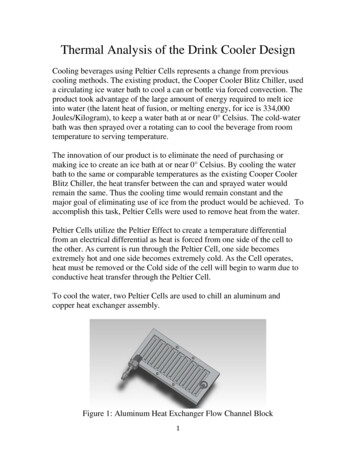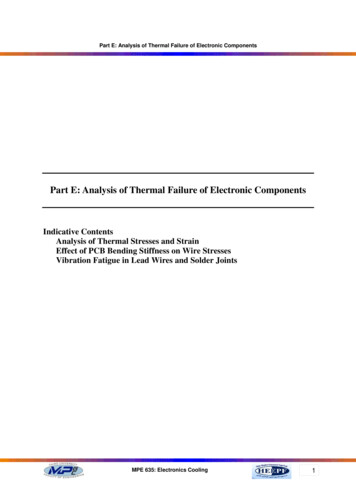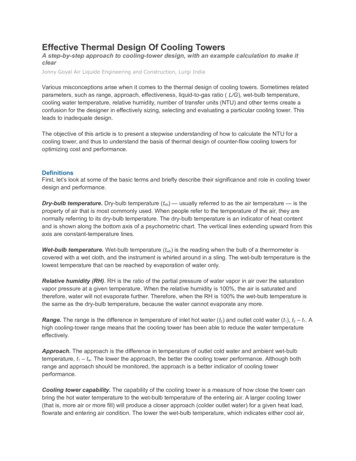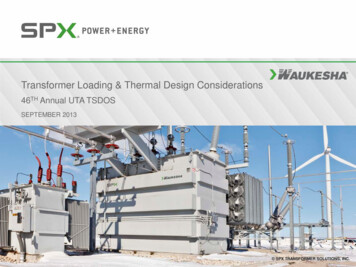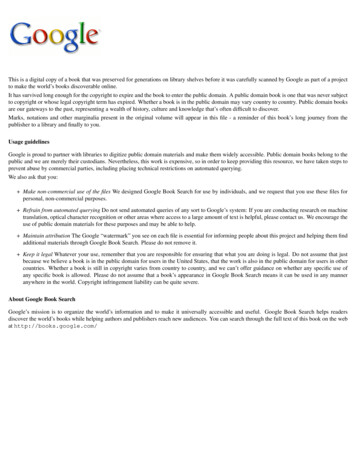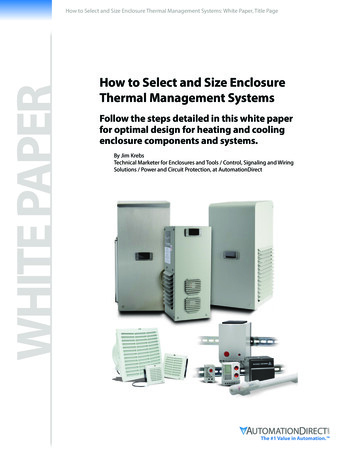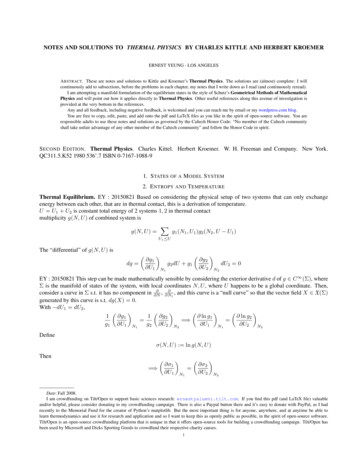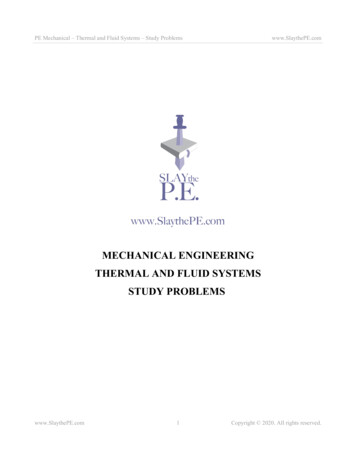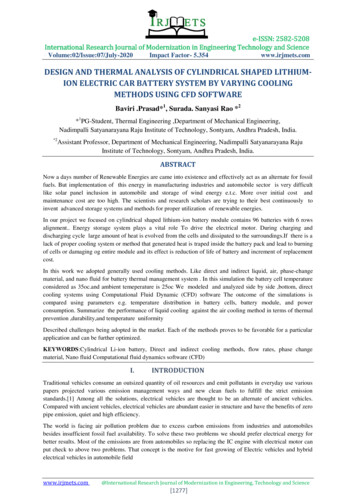
Transcription
e-ISSN: 2582-5208International Research Journal of Modernization in Engineering Technology and ScienceVolume:02/Issue:07/July-2020Impact Factor- 5.354www.irjmets.comDESIGN AND THERMAL ANALYSIS OF CYLINDRICAL SHAPED LITHIUMION ELECTRIC CAR BATTERY SYSTEM BY VARYING COOLINGMETHODS USING CFD SOFTWAREBaviri .Prasad*1, Surada. Sanyasi Rao *2*1PG-Student, Thermal Engineering ,Department of Mechanical Engineering,Nadimpalli Satyanarayana Raju Institute of Technology, Sontyam, Andhra Pradesh, India.*2Assistant Professor, Department of Mechanical Engineering, Nadimpalli Satyanarayana RajuInstitute of Technology, Sontyam, Andhra Pradesh, India.ABSTRACTNow a days number of Renewable Energies are came into existence and effectively act as an alternate for fossilfuels. But implementation of this energy in manufacturing industries and automobile sector is very difficultlike solar panel inclusion in automobile and storage of wind energy e.t.c. More over initial cost andmaintenance cost are too high. The scientists and research scholars are trying to their best continuously toinvent advanced storage systems and methods for proper utilization of renewable energies.In our project we focused on cylindrical shaped lithium-ion battery module contains 96 batteries with 6 rowsalignment. Energy storage system plays a vital role To drive the electrical motor. During charging anddischarging cycle large amount of heat is evolved from the cells and dissipated to the surroundings.If there is alack of proper cooling system or method that generated heat is traped inside the battery pack and lead to burningof cells or damaging og entire module and its effect is reduction of life of battery and increment of replacementcost.In this work we adopted generally used cooling methods. Like direct and indirect liquid, air, phase-changematerial, and nano fluid for battery thermal management system . In this simulation the battery cell temperatureconsidered as 35oc.and ambient temeperature is 25oc We modeled and analyzed side by side ,bottom, directcooling systems using Computational Fluid Dynamic (CFD) software The outcome of the simulations iscompared using parameters e.g. temperature distribution in battery cells, battery module, and powerconsumption. Summarize the performance of liquid cooling against the air cooling method in terms of thermalprevention ,durability,and temperature uniformityDescribed challenges being adopted in the market. Each of the methods proves to be favorable for a particularapplication and can be further optimized.KEYWORDS:Cylindrical Li-ion battery, Direct and indirect cooling methods, flow rates, phase changematerial, Nano fluid Computational fluid dynamics software (CFD)I.INTRODUCTIONTraditional vehicles consume an outsized quantity of oil resources and emit pollutants in everyday use variouspapers projected various emission management ways and new clean fuels to fulfill the strict emissionstandards.[1] Among all the solutions, electrical vehicles are thought to be an alternate of ancient vehicles.Compared with ancient vehicles, electrical vehicles are abundant easier in structure and have the benefits of zeropipe emission, quiet and high efficiency.The world is facing air pollution problem due to excess carbon emissions from industries and automobilesbesides insufficient fossil fuel availability. To solve these two problems we should prefer electrical energy forbetter results. Most of the emissions are from automobiles so replacing the IC engine with electrical motor canput check to above two problems. That concept is the motive for fast growing of Electric vehicles and hybridelectrical vehicles in automobile fieldwww.irjmets.com@International Research Journal of Modernization in Engineering, Technology and Science[1277]
e-ISSN: 2582-5208International Research Journal of Modernization in Engineering Technology and ScienceVolume:02/Issue:07/July-2020Impact Factor- 5.354www.irjmets.comSince 1997, Toyota and Honda have launched the Prius, Insight and Civic hybrid vehicles. And these vehiclesare extremely praised by purchasers. By 2008, Tesla free the first pure lithium-ion battery electrical vehicleTesla Roadster mileage over two hundred miles, and marked a brand new milestone of the electrical vehiclebusiness. [4]The development of electrical vehicles is facing several challenges, like battery worth, mileage, cycle life,charging time, safety and reliability. Table one lists the performance of a spread of normally used batteries.Compared with alternative batteries, lithium-ion battery has be- come back the main target of analysis due to itshigh voltage platform, high energy density, low self-discharge rate and long cycle life. However, because of itsown characteristics, the appropriate operative temperature vary of lithium-ion battery is comparatively slim, themost effective operative temperature is between 20–40 C, and also the temperature either too high or too lowaffects the performance of battery, even cause safety problems. [5]Various studies show that temperature rise is sometimes associated with the charging and discharging methodwherever heat is generated. It's necessary to find out the warmth generation method and figure out the heatdistribution inside the battery once planning a cooling system. Be- sides, heat transportation and warmthdissipation method conjointly got to be paid attention to. Thermal runaway is one in every of the key questionsof safety facing with the battery. once the temperature of the battery rises incessantly and also the heat can't bedissipated in time, thermal run- away can occur once the temperature exceeds 80 C . Thermal runaway iscommonly among the emission of harmful gases, smokes, fires and even explosions .[6]The Vasoconstrictive can scale back the discharge capability of the battery. once charging at high rate andvasoconstrictive, the development of metallic element plating can occur, and therefore seriously scale back thebattery life and cause safety issues. In recent years, the accidents of electrical vehicles happened often, andshowed increasing tendency within the last 2 years. With the increasing variety of electrical vehicles, similaraccidents can happen additional typically. Battery questions of safety can become the highest priority so as toconfirm that the battery pack will work safely and show sensible charging/discharging performance onceoperative, it's necessary to adopt BTMS to form the battery pack work effectively.The BTMS is divided into air cooling, liquid cooling, physical change material cooling and warmth pipe coolingconsistent with the cooling medium.II.METHODOLOGYa) ObjectiveThe objective of this work is to perform thermal analysis of different Battery Thermal Management System byusing different cooling methods, cooling fluids, materials and variable flow rates the has been studied usingCFD software. Comparison were made for each cooling method and other parameters were summarized forbetter cooling of batteryb) The following methodology was adopted to carry out the project:Specifications of Lithium-ion cellThe lithium cells that are understudied in this research are of type 21700 with the following properties:Table-2.1: 21700 Lithium-ion cell d discharge capacity (1C-rate)3,2AhNominal Voltage3,56 VRated Discharge energy11,4 WhDensity2560 kg/m3@International Research Journal of Modernization in Engineering, Technology and Science[1278]
e-ISSN: 2582-5208International Research Journal of Modernization in Engineering Technology and ScienceVolume:02/Issue:07/July-2020Impact Factor- 5.354www.irjmets.comHeat Capacity1000 J/(kg*K)Radial Thermal Conductivity1 W/(m2K)Axial Thermal Conductivity25 W/(m2K)Tangential Thermal Conductivity25 W/(m2K)Internal Resistace50 mΩTable-2.2: The physical and initial conditions are as shown in the table below:Battery Initial Temperature20 oCCoolant Inlet Temperature20 oCCoolant Inlet Velocity0.1 -1m/sHeat Generation0.5-2.5 w/CellCell conductivityKr 1 w/m*kKa 25 w/m*k2.3.Cooling methodsFor this study, five different battery module cooling methods were chosen, namely: Tube cooling (Side cold plate)Ethylene glycolNano fluidBottom cold plateAir coolingDirect liquid cooling (Immersion)Solid/liquid phase change material (PCM)Formulaes for the irreversible heat can be calculated using the internal resistance and current of the cell(QIrreversible I2R).The five methods were analyzed using a conjugated heat transfer CFD simulation. The module has 96cylindrical lithium-ion cells positioned in 6 rows of 16. Each battery cell has a height of 70mm and diameter of21mm.2.4.Steps Involved In Design And Simulation of CYLINDRICAL LITHIUM-ION CELL Model1. Launch CFD workbench and select ANSYS FLUENT-MSMD2. Before launching design moduler choose the materials from engineering data and add new materials data bydefining user input parameter3. Design moduler is open and construct the model4. Mesh the model5. After meshing apply the boundary conditions on model where ever applicable and make constraint thengenerate mathematical model6. Initialize the solution for give iterations7. After computational calculation load the results from modulewww.irjmets.com@International Research Journal of Modernization in Engineering, Technology and Science[1279]
e-ISSN: 2582-5208International Research Journal of Modernization in Engineering Technology and ScienceVolume:02/Issue:07/July-2020Impact Factor- 5.354www.irjmets.com8. Repeat the simulation process for every material and dimensional change and note the simulation result forbetter under standing9. Model the five battery cooling methods10. Thermal performance of direct air cooling, direct liquid cooling, indirect(jacket) liquid and PCM coolingare compared.11. Alumina Nano fluid coolants are used.12. Merits and limitations of each cooling method for occupying a fixed volume are summarized .13.In this the input is given as heat generation value varying from 0.5-2.5w/cell.14. And observe readings and compare with other cooling method values.Fig.2.1: Side by side coolingFig.2.2: Bottom cooling systemFig-2.3: liquid direct coolingwww.irjmets.com@International Research Journal of Modernization in Engineering, Technology and Science[1280]
e-ISSN: 2582-5208International Research Journal of Modernization in Engineering Technology and ScienceVolume:02/Issue:07/July-2020III.Impact Factor- 5.354www.irjmets.comRESULTS AND DISCUSSIONTable-3.1: Cooling methods vs outlet temperatures of Battery module and coolant fluids at 0.65 w/hr heat asinput for battery and 20oc for coolantS.nocoolant outlettemperature 0Ccooling method1side by side cooling system(ethyl glycol)2side by side cooling system (Aumina Nano material)3battery module finaltemperature 0C7.547.878.7046.95bottom cooling5.6513.54direct air cooling7.157.95direct liquid cooling8.517.16PCM cooling9.56.8In the above table we observe the lowest values and highest values and respective cooling methods PCMexhibits good thermal properties to remove heat from battery quickly After nano fluid takes second place toshow highest thermal propertiesGraph-3.1: Cooling method vs battery module final temperature at 0.65w/cell heat generationcooling methos vs battery module final temperature(c) at 0.65 w/cellheat )cooling methodsAbove graph show that bottom cooling shows less efficiency compare all systems PCM shows excellentefficieny in all aspectswww.irjmets.com@International Research Journal of Modernization in Engineering, Technology and Science[1281]
e-ISSN: 2582-5208International Research Journal of Modernization in Engineering Technology and ScienceVolume:02/Issue:07/July-2020Impact Factor- 5.354www.irjmets.comGraph-3.1: Cooling method vs coolant oulet temperature at 0.65w/cell heat generation initial temperature ofcoolant is 20ocTemperature(c)cooling methos vs coolant outlet temperature(c)at 0.65 w/cell heat generationinitial temperatire is 20c109876543210temperature (c)Above graph shows that Direct cooling gives good impact in reducing heat of battery after PCM materialFig-3.1: Side by side indirect cooling gives rise of temperature difference is 7.874ocAnd coolant temperature is7.87.ocfor nano fluid the battery temperature difference is 6.875 oc and outlet temp is 8.5ocwww.irjmets.com@International Research Journal of Modernization in Engineering, Technology and Science[1282]
e-ISSN: 2582-5208International Research Journal of Modernization in Engineering Technology and ScienceVolume:02/Issue:07/July-2020Impact Factor- 5.354www.irjmets.comFig.3.2: Bottom indirect cooling gives rise of temperature difference is 13.5ocAnd coolant temperature is 5.85oc.Fig.3.3: Air and liquid direct cooling gives rise of temperature difference is 7.5ocAnd coolant temperature is7.85oc.liquid gives rise of temperature difference is 7.1ocAnd coolant temperature is 8.51Fig.3.4: PCM cooling gives rise of temperature difference is 6.8ocAnd coolant temperature is 9.85oc.www.irjmets.com@International Research Journal of Modernization in Engineering, Technology and Science[1283]
e-ISSN: 2582-5208International Research Journal of Modernization in Engineering Technology and ScienceVolume:02/Issue:07/July-2020Impact Factor- 5.354IV.www.irjmets.comCONCLUSIONThis thesis illustrates the most commonly used battery thermal management systems. One of the maincontributions of this work is to present a thorough comparison of the cooling methods specific to 21700 lithiumion cells based on CFD simulations and real industrial use cases.A background on different battery thermal management solutions has been demonstrated, in particular, thosethat are more applicable in the electric vehicle and energy storage market. Four specific cooling methods havebeen simulated with the CFD software Each of the methods has been simulated to find their limits and they arecompared to one another based on the specific criteria used in the BTMS industry.1. A glance at the results of the simulation reveals that if the coolant is in direct contact with the surface of thecell (air and direct liquid), the temperature gradient inside the cell is the lowest. The oulet temperature of air is27.15 when initial temperature is 20oc2. Air cooling exhibits poor performance compare to liquid cooling because considerable high pumping powerand low heat capacity. It is also more challenging to have an evenly distributed cooling performance as air has alow viscosity that makes it flow less controllable.3. Direct liquid cooling has the greatest cooling performance since it has the most contact surface with the cellsand high heat capacity. The downside with direct liquid cooling is the complexity of the design due to itsleakage potential. The non-conducting liquids required for this type of cooling are also very costly.Oulet temperature of fluid is 20oc to 28.9Oc obviously 8.9oc difference means 15% more efficient than aircooling4. The indirect cooling methods (tube cooling and bottom cooling) have moderate performance. In contrast tothe air cooling, the temperature distribution in the module can easily be controlled as the coolant is in thermalcontact with all the cells in an identical way. The comparison between the two indirect methods shows that tubecooling induces a lower cell temperature gradient, however, bottom cooling has a simpler design.5. The indirect cooling methods (tube cooling ) have good performance when combined with nano materialscompare to pure ethylene glycol 25% more efficient than air direct cooling and 10% more efficient compare tonormal liquid flow6. As distinguished from the other cooling methods, phase change material is a reliable passive solution forbattery modules with low power capacity. A perfect application for PCM is stationary storage systems. Forhigher cooling capacities, a combination of PCM and active cooling is necessary to ensure the appropriatethermal performance. It exhibits almost 25%better than direct liquid cooling systemAll things considered, there is simply no BTMS solution that would fit all applications. it should rather bethoroughly investigated based on the requirements, using the thermal parameters namely, the temperaturegradient in a cell and a module, the maximum temperature and the required coolant flow. Furthermore, there areseveral external factors in choosing the right thermal management solution e.g. type of industry, use case, cost,safety, manufacturability, life-expectancy, and others.V.REFERENCES[1]Y. Ye, L. H. Saw, Y. Shi, A. A. O. Tay, Numerical analyses on optimizing a heatpipe thermalmanagement system for lithium-ion batteries during fast charging, Applied Thermal Engineering 86(2015)281–291.[2]A. Pesaran, S. Santhanagopalan, G. Kim, Addressing the impact of temperature extremes on largeformat li-ion batteries for vehicle applications (presentation), Tech. rep., National Renewable EnergyLaboratory (NREL), Golden, CO.(2013).[3]M. Zolot, A. A. Pesaran, M. Mihalic, Thermal evaluation of toyotaprius batterypack, Tech. rep., SAETechnical Paper(2002).www.irjmets.com@International Research Journal of Modernization in Engineering, Technology and Science[1284]
e-ISSN: 2582-5208International Research Journal of Modernization in Engineering Technology and ScienceVolume:02/Issue:07/July-2020Impact Factor- 5.354www.irjmets.com[4]M. D. Zolot, K. Kelly, M. Keyser, M. Mihalic, A. Pesaran, A. Hieronymus, Thermal evaluation of thehonda insight battery pack, in: INTERSOCIETY ENERGYCONVERSION ENGINEERINGCONFERENCE, Vol. 2, SAE, 2001, pp.923–928.[5]K. Kelly, M. Mihalic, M. Zolot, Battery usage and thermal performance of the toyotaprius and hondainsight during chassis dynamometer testing, in: Battery Conference on Applications and Advances,2002. The Seventeenth Annual, IEEE, 2002, pp.247–252.[6]Y. S. Choi, D. M. Kang, Prediction of thermal behaviors of an air-cooled lithium- ion battery systemfor hybrid electric vehicles, Journal of Power Sources 270 (2014)273–280.[7]T. Wang, K. J. Tseng, J. Zhao, Z. Wei, Thermal investigation of lithium-ion battery module withdifferent cell arrangement structures and forced air-cooling strategies, Appl. Energy 134 (2014)229–238.[8]T. Wang, K. Tseng, J. Zhao, Development of efficient air-cooling strategies for lithium-ion batterymodule based on empirical heat source model, Applied Thermal Engineering.[9]N. Yang, X. Zhang, G. Li, D. Hua, Assessment of the forced air-cooling performance for cylindricallithium-ion battery packs: A comparative analysis between aligned and staggered cell arrangements,Applied Thermal Engineering 80 (2015)55–65.[10]X. M. Xu, R. He, Research on the heat dissipation performance of battery pack based on forced aircooling, J. Power Sources 240 (2013) 33–41.[11]J. Zhao, Z. Rao, Y. Huo, X. Liu, Y. Li, Thermal management of cylindrical power battery module forextending the life of new energy electric vehicles, Applied Thermal Engineering 85 (2015)33–43.[12]S. K. Mohammadian, S. M. Rassoulinejad-Mousavi, Y. Zhang, Thermal management improvement ofan air-cooled high-power lithium-ion battery by embedding metal foam, Journal of Power Sources 296(2015)305–313.[13]A. A. Pesaran, S. Burch, M. Keyser, An approach for designing thermal management systems forelectric and hybrid vehicle battery packs, Proceedings of the 4th Vehicle Thermal ManagementSystems (1999)24–27www.irjmets.com@International Research Journal of Modernization in Engineering, Technology and Science[1285]
CFD software. Comparison were made for each cooling method and other parameters were summarized for better cooling of battery b) The following methodology was adopted to carry out the project: Specifications of Lithium-ion cell The lithium cells that are understudied in this
